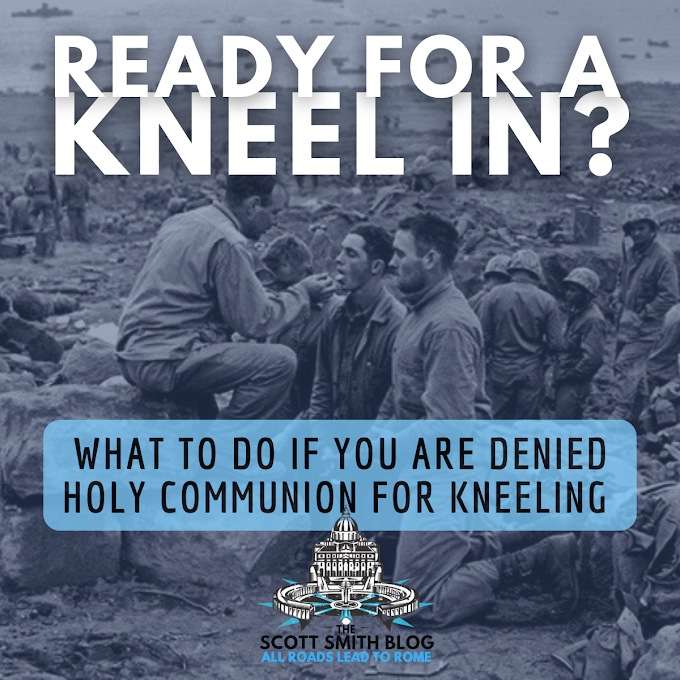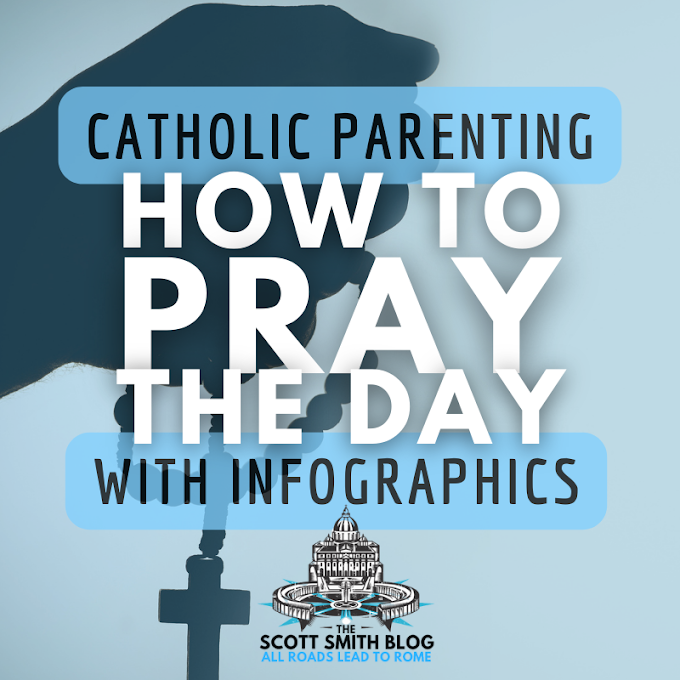I published a book on St. John Paul II and the Rosary ... or at least I thought I did.
It's amazing how your creation can take on a life of its own. This is the grace of creation. We especially receive this grace with childbirth and as we watch our kids' personalities develop and unfold. It's also true with artwork and writing.
So, I realized recently that I didn't really put this book together. St. John Paul II did.
Whether he intended to or not, St. John Paul II gave a series of homilies through his life that perfectly matched the mysteries of the Rosary. They were just waiting there for us to collect into a single volume.
That's what this book is. I compiled excerpts of homilies and encyclicals from St. Pope John Paul II on the Rosary and organized them according to the individual mysteries of the Rosary.
Already have a copy? Scroll down for the many different ways you can use this book to enhance your experience of the Rosary.
Or, click below to purchase a copy of Pray the Rosary with St. John Paul II, now also an audiobook:
I also put together a book like this for Blessed Anne Catherine Emmerich, Pray the Rosary with Blessed Anne Catherine Emmerich, which you can purchase at this link:Praying the Rosary with St. John Paul II - Table of Contents
Origin and History of the Rosary, plus How to Pray the Rosary
If you need help praying the Rosary, I have prepared a How to Pray the Rosary Guide in this article, which also describes the origin and history of the Rosary. I stuffed pretty much all I could into this article.
St. Pope John Paul II and the Rosary: How to Take the Rosary to the Next Level
St. John Paul II wrote an entire encyclical on the Rosary entitled Rosarium Virginis Mariae, "The Rosary of the Virgin Mary." Here is a link to the full text of that encyclical from the Vatican website.
In Rosarium Virginis Mariae, JP2 describes how Christians can enter more deeply into the mysteries of the Rosary. You don't need yoga and yogis for great meditation. The Church is already full of ancient traditions for meditation.
St. John Paul II encourages not to be put off my all the repetition. Repetition is the means by which we assimilate the mysteries of Christ's life:
If this repetition is considered superficially, there could be a temptation to see the Rosary as a dry and boring exercise. It is quite another thing, however, when the Rosary is thought of as an outpouring of that love which tirelessly returns to the person loved with expressions similar in their content but ever fresh in terms of the feeling pervading them.
John Paul wants us to think of this as insistence, not repetition. Jesus, Himself, uses repetition to bring us closer to Him. Think of how often we return to the Sacrament of Reconciliation to confess the same sins.
Or think of when Jesus repeatedly asked Peter whether he loved him following the Resurrection:
If we needed evidence for this from the Gospel, we could easily find it in the touching dialogue between Christ and Peter after the Resurrection: ―Simon, son of John, do you love me? Three times this question is put to Peter, and three times he gives the reply: ―Lord, you know that I love you. Over and above the specific meaning of this passage, so important for Peter‘s mission, none can fail to recognize the beauty of this triple repetition, in which the insistent request and the corresponding reply are expressed in terms familiar from the universal experience of human love. To understand the Rosary, one has to enter into the psychological dynamic proper to love.
St. John Paul II described the Rosary as mankind's answer to deeper meditation and contemplation. JP2 also described some misguided attempts by Catholics to seek deeper meditation outside Christianity:
Some Christians, limited in their knowledge of the Christian contemplative tradition, are attracted by those forms of prayer.
The Rosary should involve our imaginations, John Paul II explains:
Announcing each mystery, and perhaps even using a suitable icon to portray it, is as it were to open up a scenario on which to focus our attention. The words direct the imagination and the mind towards a particular episode or moment in the life of Christ.
St. Pope John Paul II makes reference also to Ignatian Spirituality and how this method of contemplation can be used to break open the Rosary:
In the Church's traditional spirituality, the veneration of icons and the many devotions appealing to the senses, as well as the method of prayer proposed by Saint Ignatius of Loyola in the Spiritual Exercises, make use of visual and imaginative elements (the compositio loci - composition of place), judged to be of great help in concentrating the mind on the particular mystery
St. John Paul II's Jubilee Pilgrimage to Rosary Sites in the Holy Land
- March 21, 2000 - The Baptism of Jesus (Luminous Mysteries, the ones JP2 added): Saint John Paul II prayed at Wadi Al-Kharrar at the River Jordan, where it is believed St. John the Baptist baptized Jesus;
- March 22, 2000 - The Nativity of Jesus (Joyful Mysteries): Saint John Paul II celebrated Mass in Manger Square in the Palestinian Territories of Bethlehem, near the site of Jesus' birth and manger
- March 23, 2000 - Pentecost (Glorious Mysteries) and the Institution of the Eucharist (Luminous Mysteries): Saint Pope John Paul II celebrated a private Mass on March 23, 2000 in the Cenacle, the Upper Room where the Holy Spirit came upon the Apostles as a mighty wind at Pentecost and where Jesus instituted the Eucharist at the Last Supper
- March 25, 2000 - The Annunciation (Joyful Mysteries): Saint John Paul II celebrated Mass in the Basilica of the Annunciation in Nazareth during his Jubilee Pilgrimage to the Holy Land;
- March 26, 2000 - The Sorrowful Mysteries (All), plus the Resurrection of Jesus (Glorious Mysteries): Saint John Paul II prayed the Angelus in Jerusalem, speaking on Christ's Passion, Death, and Resurrection, as well as the Assumption of the Virgin Mary.
- March 26, 2000 - The Death of Christ (Sorrowful Mysteries) and the Resurrection of Jesus (Glorious Mysteries): Saint John Paul II celebrated Mass in the Church of the Holy Sepulchre in Jerusalem
How to Use the Book, Praying the Rosary with Saint John Paul II
- The Annunciation chapter, for example, is from a homily John Paul II gave at the Basilica of the Annuciation in Nazareth.
- The Baptism of Jesus chapter is from a homily JP2 gave at the Wadi Al-Kharrar at the River Jordan, where Christ may have been baptized.
There are two basic ways to pray the Rosary with this book: the short form and the long, at-home retreat form. That is, as far I have envisioned. Please comment below if you come up with any new ways of using Pray the Rosary with John Paul II.
 |
| Basilica of the Annunciation, Nazareth |
Short Form: Praying your Daily Rosary with St. John Paul II
Since there is a chapter for each mystery of the Rosary, read a little bit of each chapter with each decade or with each bead.
Take a paragraph or short passage - what's called a "pericope" - from St. John Paul's homily or writing. Meditate on this passage as you say the entire decade or just a single bead. Contemplate on the scene the pope presents or Meditate on his words:
If St. John Paul is describing a Biblical scene or location, contemplate that scene. Imagine yourself there watching the scene unfold. Or, take part in the scene. Imagine yourself as one of the people in the scene. Use the rhythm of the Hail Marys to keep you focused on the scene. If you are really enjoying the experience or you feel Jesus calling you to stay there, stay there as long as you want. You could stay there for the whole Rosary, if it is an especially rich experience.
If St. John Paul is providing insights into Scripture or philosophy, meditate on his words using lectio divina or another technique. If you are unfamiliar, the basic idea of lectio divina is reading and reading the short passage and paying attention to what stands out. Focus on those words. What do they mean to you right now?
Long Form: Read an Entire Chapter of Pray the Rosary with Saint John Paul II
Long form: Read the entire chapter before or during each decade. This can be done throughout the day. Split up the decades over the course of your day. For example, pray decades (1) when you wake up, (2) after breakfast, (3) at lunch, (4) before or after dinner, and (5) before bed.
You can buy a copy here: Pray the Rosary with St. John Paul II, now also an audiobook:
At-Home Retreat - The "Super-Long" Form:
I noticed recently that the mysteries of the Rosary can match the Four Weeks of the Spiritual Exercises of St. Ignatius. In particular, the mysteries prayed Monday through Thursday are very close to the rhythm and movements of the Spiritual Exercises: Joyful, Sorrowful, Glorious, and Luminous.
So, for an At-Home Retreat (ideal for pandemic days), spend four days praying the Rosary in long-form. Spend four days dedicating five hours per day to contemplating the mysteries of the Rosary. As described above, dedicate five prayer periods throughout the day, however you want to organize it. Read the chapter-excerpt from JP2 before or during each decade of the Rosary.
This is like a "Preached Retreat" preached by none other than St. Pope John Paul II!
Other Options for Praying the Rosary with JP2?
Please let me know about your experiences with St. John Paul II and praying the Rosary. Any other ideas on how to use this book? I have a feeling that the depths of St. John Paul II's writings will not easily be exhausted. God bless!
Totus Tuus Prayer of St. Pope John Paul II
Totally yours,
Immaculate Conception, Mary my Mother,
Live in me, Act in me,
Speak in me and through me,
Think your thoughts in my mind,
Love through my heart,
Give me your dispositions and feelings,
Teach, lead me and guide me to Jesus,
Correct, enlighten and expand my thoughts and behavior,
Possess my soul,
Take over my entire personality and life, replace it with Yourself,
Incline me to constant adoration,
Pray in me and through me,
Let me live in you and keep me in this union always.


















0 Comments